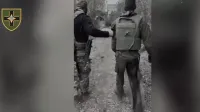Russia may try to open second or even third front in Europe — U.S. General Clark
global.espreso.tv
Sun, 26 Oct 2025 17:29:00 +0200

The legendary American military leader, four-star U.S. Army General Wesley Clark, served as Supreme Allied Commander Europe from 1997 to 2000. A veteran of the Vietnam War, he was wounded in combat and distinguished himself through remarkable courage and leadership on the battlefield.Thank you for the invitation.“Tomahawks, Tomahawks” – Donald Trump keeps tossing the name around. Here in Ukraine, we’re waiting and hoping for a decision from the Pentagon, but so far, there hasn’t been one – diplomacy is still at play. Meanwhile, Putin seems to ignore, and perhaps even mock, the American president. Talks in Budapest remain uncertain, with cancellations one after another. Still, we hope that sooner or later, the Tomahawk issue will be resolved in Ukraine’s favor.Do you think there’s a real chance that Ukraine could receive these legendary American missiles?I think it’s unlikely that Ukraine will receive Tomahawk missiles. Tomahawk missiles would be a good addition to what Ukraine already has for deep strike. More importantly, the Tomahawk would symbolize U.S. determination to put additional military pressure on Mr. Putin. In my view, that extra military pressure is necessary to convince Putin that he will not win. This is the missing element today in U.S. strategy.We should provide Ukraine the military assistance it needs, in addition to what the Europeans are supplying, to convince Putin that no matter what he does, no matter how many soldiers’ lives he sacrifices on the front line or how many drones he sends to attack civilians in Ukraine, he will lose.Until he believes he will lose, I am afraid he will continue this. I was pleased to see the president cancel a meeting in Budapest. Given what Minister Lavrov said, the Russian objectives have not changed. They want all of Ukraine. They want Ukraine neutralized and unable to defend itself.This is simply unacceptable, not only in principle but certainly to the people of Ukraine. In the United States we know you are fighting for us. The values you are defending are our values, and you have majority support from the American people. We will do everything we can to help you.How did you view the meeting between Pentagon Chief Pete Hegseth and President Donald Trump with the top U.S. military leadership? At that gathering, they outlined an updated American military doctrine and introduced new rules of engagement. How seriously should we take Hegseth and Trump’s statements about the “peace through strength” doctrine?I think we have to take what Secretary Hegseth and President Trump said very seriously. But strategic realities nevertheless exert a gravitational pull on U.S. policy.For many years the United States has claimed it would pivot to Asia, that it would do less for Europe, and that Europe would have to take care of itself. But the reality is that Europe is the greatest trade and investment partner of the United States.If Ukraine is destabilized, Europe itself will suffer, and that will bring immediate hardship to the United States. So no matter what the preferences or theories about China may be, we must understand the reality, and that reality keeps pulling the United States back to Europe.Not only through trade and investment, but also because China is increasingly involved through its so-called “unlimited” partnership with Russia. The United States is reluctantly beginning to understand at the policy level that it cannot deter China in the Pacific if it does not support Ukraine in Europe.The first year of the war made it clear that Russia was unprepared for the kind of conflict it had envisioned on paper. Now, however, Moscow has managed to some degree to stabilize both its domestic situation and the front lines. There are no major victories for Putin to showcase, and the once-touted Russian army is now viewed with skepticism around the world. Still, this doesn’t make things any easier for Ukraine – war is ultimately about resources, and not only military equipment but human lives as well. Do you see any strategic direction that could truly shift the course of this war?This is an important question. Historically, the Russian soldier, the Russian peasant, the uninformed and non-participating Russian has been subjected to an incredible wastage of life for centuries.In the Russian way of war, a soldier is treated like an artillery projectile. It is about how many soldiers, how many shells, and how fast you can expend them. This mindset is clearly reflected in Russia’s conduct on the battlefield today. They believe in mass.Stalin is reported to have said that quantity has a quality all its own. That may be true, but Ukraine is fielding an army that is technologically more advanced, better trained, and provides stronger support for the individual soldier. And Ukraine is winning, step by step, the technology race that gives its army the quality to repel the quantity of Russian forces. That is how it works on the battlefield, and the United States has learned this lesson at great expense over the last seventy years.In World War II we discovered that American soldiers were not as well trained as German soldiers. It took years to replace and supplement basic and advanced individual training with team and small-unit training, which gave us a decisive edge on the battlefield.We have that training now and we have provided it to Ukrainian units, soldiers, and leaders who come to the West. It is also taking root inside the Ukrainian military. You are leading the way in adapting to a drone-enabled battlefield. Ukraine is the unfortunate laboratory for new methods of warfare and we are learning from you, but at the heart of this is the old question of quality versus quantity.As long as you maintain a qualitative edge through well-trained soldiers, high morale, strong care and support from the chain of command, and the ability to gain tactical and strategic technological superiority, you will eventually prevail.You fought in a war that was far from popular in the United States, the conflict against the Vietnamese communists. You were wounded in battle and understand, perhaps better than anyone, what true valor and courage mean, timeless qualities that have defined soldiers for centuries. Do you think the experience of the Vietnam War could be relevant for Ukraine today, given that modern warfare has evolved with drones becoming a key strategic factor and reshaping the role of armored forces? And on a personal level, what was the most difficult part of your experience in Vietnam?First of all, my heart goes out to the civilians in Ukraine who are unlawfully attacked night after night and day after day by Russian drones, missiles, and rockets. It is illegal, it is unlawful, and it is a terrible form of suffering in warfare. But it is done deliberately by Mr. Putin to demoralize the civilian population of Ukraine.As far as I can tell, it is not working, but it is enormously painful. I wake up every morning to reports of more people injured or killed, more innocent Ukrainians disabled by Russian attacks – unlawful attacks aimed at destroying civilian morale rather than military targets. That is my first feeling.My second feeling is one of enormous admiration and sympathy for the Ukrainian soldiers. They are incredibly strong, determined, skilled, and resilient, and they will ultimately succeed against the Russians on the battlefield.The latest innovation introduced by General Syrskyi with the assault groups to push back Russian infiltrations seems to be working. It is another example of staying ahead tactically through innovation, not only in technology but also in organization and responsiveness. I have great respect and admiration for the Ukrainian armed forces.For the leadership of Ukraine, it is essential to reach out to Europe as well as to American partners to seek assistance and to share lessons learned. We are grateful that you are sharing those lessons, helping us to understand the realities of the battlefield.I was wounded in Vietnam, and a helicopter came to pick me up from the battlefield. I was a captain commanding an infantry company. That is not happening in Ukraine.I think every day about the courage of Ukrainian soldiers who are wounded yet remain resilient, waiting for evacuation by a drone, an unmanned vehicle, or brave drivers in an armored personnel carrier. It shows the immense difficulty of this kind of combat.This is a war of millions, not a conflict confined to specific fronts or limited objectives. The Russians are not just fighting Ukraine; they are training new forces, expanding the production of lethal weapons, improving their combat coordination, and engaging in consultations with North Korea and China. They show no intention of winding down their war. At the same time, they are taking some heavy blows.How do you see this broader strategic contest in a war of millions, and what do you think the enemy’s next moves might be?I believe that Russia intends to continue fighting until it realizes it is losing and then takes a pause. It will keep fighting in Ukraine and may even open a second or third front elsewhere in Europe. Russia’s industrial base is working around the clock, seven days a week, to produce greater quantities of weapons.It is being assisted by Chinese technology, by North Korean troops, and by Iranian drones. In this way, it is forming an alliance to strengthen its war against NATO. It is very difficult for a democratic government or a democratic leader to mobilize national resources for a war that exists in a gray zone.This is the challenge of the Russian strategy. They can mobilize through their command economy, where there are no elections, no democracy, and no choice for the people. They are misinformed and misled into believing they are at war with NATO, while NATO does not seek war with Russia.However, NATO is slowly coming to the realization, one nation at a time, that it must take stronger action against Russian hybrid warfare and gray zone attacks. This includes everything from shooting down aircraft and drone incursions to taking measures against the shadow fleet and increasing vigilance in counterintelligence efforts.Russian gray zone attacks are escalating. They are designed to weaken the resolve of NATO governments, to frighten NATO voters, and to intimidate those governments that are preparing to strengthen their defenses.This is an effective Russian strategy against democratic nations in the West. And, as always, the West will be slow to respond, but it will eventually respond effectively.In the meantime, it is critical that Ukraine holds its positions, does everything possible to exhaust Russian forces, distract them from further operations, maintain its ground, and prepare to regain sovereign control of its territory.The Russians have adopted a deliberate and criminal strategy, systematically targeting Ukraine’s energy infrastructure. They are striking power facilities and gas distribution systems in an effort to cause maximum suffering to our people. Given the harshness of Ukrainian winters, this could lead to countless deaths – a clear act of genocidal warfare. At the same time, there are numerous military installations across Russia that are regularly struck by drones and missiles. How effective is Russia’s air defense system and its strategy for protecting key military and strategic sites? And could a series of well-executed precision strikes compel Russia to come to the negotiating table?Ukraine has adopted an effective strategy of going after key resources. The most critical of these is Russian oil production and refining. Russian oil exports are a primary source of funding for the regime; they supply the resources Russia needs to wage war and to pacify its civilian population.These attacks, which have disabled perhaps a quarter of Russian oil refining capacity, have been effective. They are lawful because they target military-relevant infrastructure. The task now is not only to expand the range of strikes against these critical resources, but also to continue disabling facilities that have already been hit: pipelines, pumping stations, refineries, and storage tanks.You must continue to re-attack old targets and expand your ability to strike new ones. That is the challenge. Russia also faces its own problem. In the past the vastness of Russia was an advantage because invaders could not cope with the scale of its terrain.In modern warfare that vastness is no longer the same kind of advantage. It can be a disadvantage because more and more Russian resources must be devoted to air defense to stop deep attacks.So far the majority of the effort appears to be effective against the petrochemical complex. This is a wise move. It mirrors the strategic attacks the United States and Britain found most effective against Nazi Germany in World War II. Modern forces need oil, gas, and lubricants.When you attack these resources, you are striking the heart of the enemy’s ability to wage war. The difference is that when the Allies did this in World War II, a ground invasion followed, so they sustained the campaign for a limited period. We do not know what the time limits are for operations in Ukraine.There will be a continuing need to advance technologically, increase production, and improve the intelligence and targeting of deep assets that Ukraine must strike inside Russia. The reason is that Russia will strengthen its defenses.So again, the technology race and the strategic competition involve not only the front line but also the depth of Russian territory. This, I think, is the key factor.What Russia wants to do is attack and destroy the morale of the Ukrainian population by going after energy systems, heating plants, and similar infrastructure. Ukraine is well aware of this.I think the Ukrainian government has pursued a wise policy of dispersing energy production, and to a large extent it is workable. Not without hardship, but survivable for Ukraine. This will be the test this winter.We know that forecasting the future course of the war depends on certain indicators, and Russia’s are quite clear. The Russians have long relied on overwhelming numbers to solve military problems – it’s a war of millions. Based on open and semi-open sources, where do you see Russia preparing to build up its manpower and equipment? They have been increasing pressure in the north, particularly in the Chernihiv and Sumy regions, where their attacks on civilian targets have grown more brutal. At the same time, the situation remains extremely difficult in the Donbas and along the administrative border of the Dnipropetrovsk region, while the south also remains a key area.Taking all this into account, based on what we currently know about the front line, where do you see the main concentration of Russian forces and their likely next moves?I am at a considerable distance and do not receive daily battlefield reports hour by hour. I know your generals do, and I think they are doing a good job. As I assess the Russian strategy, it looks like this.Their strategic objective is Odesa. If they can take Odesa, they can isolate Ukraine from its export routes and cripple the country economically. The likely plan is a breakthrough from Zaporizhia and Kherson into Mykolaiv and Odesa to seal Ukraine off from the Black Sea. To attain that objective, they are trying to do two things. First, they want to pull Ukrainian forces to the north, which is why they have attempted attacks into Sumy and toward Kharkiv. Second, they want to draw Ukrainian forces in.At the same time, around Pokrovsk, if they can seize the city and take control of the road and rail intersections in the center of the Donbas, they can put additional pressure on Ukraine, which would facilitate the later seizure of Odesa. It is a broad front and an obvious campaign. It must be met step by step by Ukrainian forces that wisely understand Russia’s strategic military objectives and carefully manage the deployment of Ukrainian reserves to block Russian progress around Bakhmut, resist in the south, and prevent Russia from seizing control of the north coast of the Black Sea.








